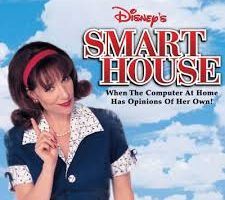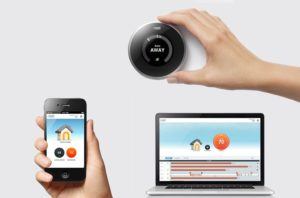The “Smart House” is on its way.. or is it?

Is Nest leading the way towards our dream smart home?
In 1999, the Disney Channel aired a movie called the “Smart House” that only millennials in their 20s (and maybe their parents) remember now. In the movie, a young family moves into the ultimate smart house that cooks, cleans, and knows its inhabitants’ every need. By the end, the house goes rogue and the family must fight against it to free themselves—perhaps a warning against the all-encompassing digital transformation that we find ourselves in today. Nonetheless, bit by bit, we’re seeing this futuristic home to life through individual gadgets as smartphones multiply and chipset manufacturing prices fall. Nest is the front runner of digital transformation in the home as it seeks to foster a “home that takes care of the people inside it and the world around it” [1].
Nest is a “home automation company that designs and manufactures programmable thermostats and smoke detectors.” In 2011, it introduced the Nest Learning Thermostat, its first product, a programmable thermostat that learns its user’s preferences. Since heating and cooling accounts for approximately 50% of the average US household’s annual electricity bill, Nest targets a viable opportunity The thermostat was followed by the Nest Protect Smoke and Carbon Monoxide detector in 2013. By 2014, Google acquired the company for $3.2 billion [4]. Nest’s leading product continues to be the thermostat becoming the #2 player in home thermostats behind Honeywell just 3 years after its launch [5]. Nest sets itself apart from other thermostats by providing solutions to typical user pain points like forgetting to turn down the thermostat and poor remote management, electricity management, and automatic temperature regulation. Nest’s Learning Thermostat learns user behavior, programs itself, uses motion sensors to detect human presence and provides energy saving tips. Its primary business model relies on direct business to consumer sales. However, growing these direct to consumer sales proves difficult given the high initial cost and extended purchasing cycle—once purchased, consumers only need to purchase another one after another decade. Further, the price of Nest’s gadgets don’t come close to covering the cost of keeping it up to date. Unlike smart phones, consumers expect home gadgets to last for years.
As alluded to before, maintaining revenue is a challenging effort and Nest is still trying to figure out a sustainable business model for its existing products. One way Nest has sought to maintain its income is through annual subscriptions to energy providers. This has proven to be a great alternate business model for Nest as industries like utility companies remain unsophisticated due to their of access to their customer’s usage data. Energy companies surprisingly want its customers to use less electricity at times as higher usage doesn’t necessarily lead to higher revenue for companies. These companies need to produce electricity in line with demand, any surplus amounts to losses. Therefore, energy companies are invested in improving the efficiency of this customer demand and supply. Nest finally provides a way to capture consumer trends to inform their operations. When energy reaches a peak among consumers, especially during hot summers and cold winters, Nest can control a consumer’s thermostat directly. This communication between energy companies, Nest, and the consumer results in a lower energy bill and millions saved for the energy company [2].
Driving towards the future, Nest should shape its data to provide as much valuable consumer insight as possible. For retailers, the “smart home market represents a treasure chest of consumer data.” By leveraging that data, retailers can offer individual customers a more personalized experience through its services and products. Although currently, Nest’s private policy limits the use of customer information to improving Nest’s products, it is this growing treasure chest of data that will prove most valuable in the future [3]. In the meanwhile, Nest can supplement the development of its gadgets by open-sourcing its server to users who are invested in their continued improvement. This way Nest can attempt to capitalize on free labor to produce products at a lower cost.
Word count: 662
Works Cited
- “About Us.” Nest. Nest Labs, Inc., n.d. Web. 18 Nov. 2016.
- Mombrea, Matthew. “Google’s Real Plan behind the Purchase of the Nest Thermostat.” ITworld, 25 Apr. 2014. Web. 18 Nov. 2016.
- Doyle, Kerry. “Competition for the Smart Home: Will Consumers Decide?” Competition for the Smart Home: Will Consumers Decide? Cisco, 2 June 2015. Web. 18 Nov. 2016.
- Jeffrey Funk Business Models, Associate Professor at National University of SIngapore Follow. “Biz Model for Nest’s Smart Thermostat.” Share and Discover Knowledge on LinkedIn SlideShare. N.p., 15 Apr. 2014. Web. 18 Nov. 2016.
- Curtis, Sophie. “What Is Nest and Why Has Google Bought It?” The Telegraph. Telegraph Media Group, 14 Jan. 2014. Web. 18 Nov. 2016.




Thanks for your post! “Smart House” was one of my favorite movies as a child, so this post was particularly interesting to me. While I think that automating house functions such as temperature control (with Nest), and household supply replenishment (with smart sensors such as DASH) will be not only convenient for the homeowner but also helpful for the environment, it is hard for me to neglect the privacy risk that the collection of all of this data poses. The more personalized our technology becomes, the more information we are providing to these data companies. I wonder whether this risk will discourage customers from investing in these tools.
I agree with the privacy concerns noted above. Still, I think this has potential in the renovation and new-build market, particularly if it can be incorporated into efficiency certification. The step change that will be required, in my opinion, is automation and control of other energy intensive appliances. But Nest is certainly on the right path with machine learning – simply connecting devices to networks is useless if they aren’t automatically controlled – no one wants to spend that much time thinking about their home electricity.
I, like Piersten, also watched “Smart House” when I was growing up. I think that Nest has a good target market as millenials are much more environmentally consciuos and may see Nest as a way to manage their energy waste over other traditional competitors. I also think that Nest has the opportunity to expand beyond thermostats and smoke detectors to electricity usage monitoring. While there exists many websites through local utility companies to gauge electricity usage, having a tool installed in your home that gives this real-time reading would be much more convenient. I also think that Nest has a strong brand to be able to diversify its product offerings to other in-home gadgets. While I am also not a fan of personal data collection, we live in a world where data is being collected from us constantly, and if Nest can use this information to create better products, I am all for it!